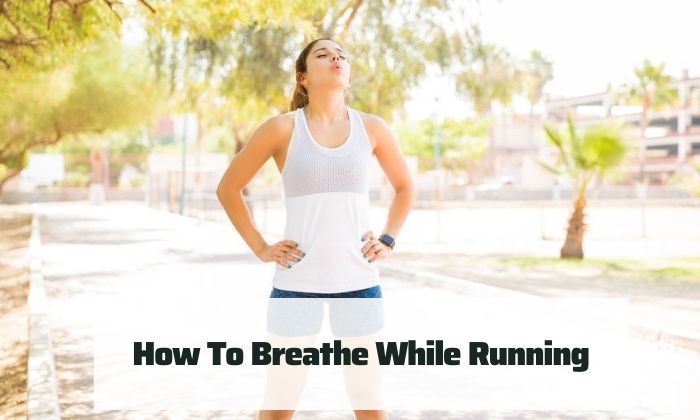How To Breathe While Running – Best Effective Tips

As a new runner, you’ve probably given little thought to how to improve your breathing while running. Who needs to be taught how to breathe, after all? However, as you progress through your journey into the world of running, you will begin to consider concerns about improving performance, gaining a better understanding of proper technique, and wondering how to improve breathing while running.
Most runners, in fact, could benefit from learning a few breathing techniques. Understanding how to improve your breathing while running will not only improve your performance, but will also help you avoid common injuries that afflict runners.
Here are some tips on how to improve breathing while running so you can get your breathing under control and have a great run every time.

Why does it feel difficult?
Running, for example, causes your muscles and respiratory system to work harder than usual. You need more oxygen and must remove carbon dioxide buildup, which can make breathing difficult.
The quality of your breath can indicate your level of fitness or how well your body responds to the pace and intensity of your run. If you work too hard or push yourself beyond your limits, you may experience shortness of breath, wheezing, or chest tightness.
6 Types of Breathing Techniques for Running
Though breathing is an autonomic activity that we rarely think about, establishing an efficient breathing cadence while running can help you increase your endurance, reduce your risk of injury, and break through a training plateau. Here are five different breathing techniques that you can use while running.
1. Rhythmic breathing
As a runner, your body absorbs a lot of stress when your exhalations match your foot strikes. Running with a rhythmic breath helps you distribute this stress evenly across both sides of your body. This practice entails matching your inhalations and exhales to the cadence of your steps, so that your exhales alternate between right and left foot strikes.
For runners, a natural breathing rhythm is to inhale for two footstrikes and exhale for two footstrikes. This, however, means that your exhalations will always be on the same side of your body, resulting in uneven strain and possibly increasing your risk of injury.
If you breathe in an odd ratio, such as inhaling for two strides and exhaling for one, or inhaling for three and exhaling for two, each exhale will correspond with an alternating right or left foot strike. Variability like this can improve your endurance while also lowering your risk of injury.
2. Diaphragmatic breathing
Diaphragmatic breathing is a breathing technique that involves engaging the diaphragm, a dominant respiratory muscle near the lower ribs and intercostal muscles, to breathe more efficiently. During this type of breathing, the diaphragm contracts and moves downward, allowing the lungs to expand and take in more air. During strenuous exercise, this deep belly breathing technique, which increases lung capacity and elasticity, can help slow your breathing rate and heart rate.
3. Breathing in the box
When stressed, box breathing, also known as square breathing or four-square breathing, is a four-part breathing exercise that can restore calmness and wellbeing to the mind and body. In this deep-breathing technique, inhale deeply into the belly, hold the breath at the top of the inhalation for at least four counts, exhale, then hold the breath at the bottom of the exhalation for four counts.
4. Breathing through the nose vs. breathing through the mouth
Whether you breathe through your nose or your mouth during a run is mostly a matter of personal preference. The most important thing is that your breathing is comfortable and efficient, which is why many runners will instinctively switch between nose and mouth breathing. Inhaling through the nose and exhaling through the mouth are required.
5. Nasal breathing
Nasal breathing is preferable for easy runs or moderate jogs rather than sprints (though many experienced athletes will have their own preferred methods of breathing). Nasal breathing involves only inhaling and exhaling through the nostrils, with no mouth breathing.
6. Mouth breathing
Mouth breathing consists solely of inhaling and exhaling through the mouth. Breathing through your mouth during a run can cause stress because it may feel like hyperventilation. Breathing through your mouth, on the other hand, can be very effective for high-intensity running. During a sprint or an uphill run, people frequently switch to mouth breathing.

4 Tips for Breathing While Running
Weather, asthma, fitness level, and the intensity of your run can all influence how you breathe while running. If you’re a new runner or simply want to learn how to get enough oxygen while exercising, here’s a primer on how to practice efficient breathing while running.
1. Warm up your lungs.
A proper dynamic warm-up can get your heart pumping and your blood flowing, which can help prepare your respiratory system and loosen your muscles so you can expand your lungs and diaphragm more easily. Before you run, try some chest-opening exercises to help your diaphragm expand and your belly breathing become more efficient.
2. Maintain your running form.
Proper running form and good posture can help you build core strength and relieve core pressure, making it easier to breathe while running. Keep your head and neck in a neutral position and your eyes forward. Throughout the movement, keep your chin tucked, as if you were holding an egg under your chin. Your posture should be tall with a slight forward lean. Your shoulders should be level and relaxed at all times.
3. Breathe through your nose and mouth.
If you only breathe through your nose or mouth, you may not be making the best use of your lung capacity, leaving you with less oxygen as you exercise. Inhaling through both your nose and mouth can help you get the most oxygen. Breathe in rhythmically through your nose and mouth as you run, timing your breathing rhythms with alternating steps. Exhale through the mouth to aid in the rapid expulsion of carbon dioxide.
4. Practice belly breathing.
Deep breaths may appear to slow you down, but this is not the case. During strenuous exercise, chest breathing causes shallower breaths, depriving your body and muscles of much-needed oxygen. Instead, practice breathing through your diaphragm. Lay on the ground with one hand on your chest and one on your belly to practice belly breathing. Inhale through your nose and exhale as your lungs fill up with air. Simultaneously, press down on your diaphragm to keep your chest from rising. You can exhale gently through your mouth and repeat for a few minutes. Once you’re used to it, try incorporating it into your next run and notice the difference.
Before making any changes to your exercise routine, consult with your running coach or a qualified medical professional if you have any medical conditions that may affect your breathing.
The bottom line
You can improve your running breathing patterns with the right tools. These simple techniques can help you breathe and run to your full potential. Aim to run at a pace that allows you to breathe easily and hold a normal conversation without gasping for air.
Develop the habit of paying attention to your breath not only while running, but also at other times throughout the day. Remind yourself to breathe smoothly and evenly, and pay attention to any variations, as well as how your breath reacts to different situations or activities. See more useful article at my website y2kcenter.org




